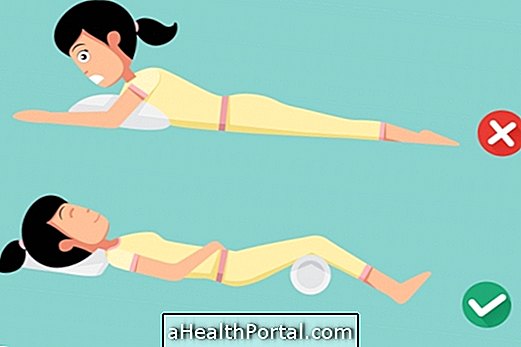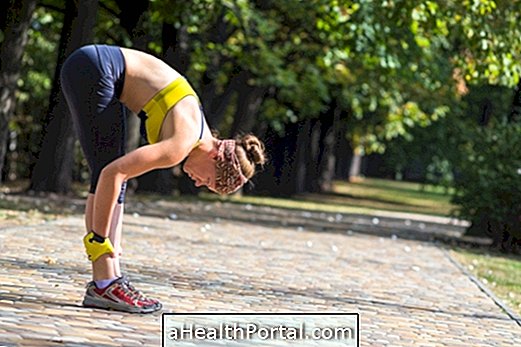The best sleeping position is on the side because the spine is well supported and in a continuous line, which fights back pain and prevents spinal injuries. But for this position to be beneficial you should use 2 pillows, one in the neck and the other between the legs.
On average, a night's sleep lasts from 6 to 8 hours, so it is important that during this rest period the joints, especially the spine, are not overloaded. In addition, the sleeping position influences snoring, reflux and even favors wrinkles.
Advantages and disadvantages of each position

1. Sleeping on the stomach
Sleeping belly up with a supported pillow favors the anterioration of the head, which ultimately favors the hunchback posture. It can also cause pain in the lower back because the lower back is under pressure. This position also favors snoring and sleep apnea because the tongue slides back and hinders the passage of air through the throat.
- When it may be a good choice: if there is pain or changes in the shoulder, if you are on anti-wrinkle creams at night if you have a face sore. By putting a cushion not only on the neck, but also on the back, it can be useful for lying down, which facilitates breathing in case of flu, for example. Placing a very thin pillow under the neck and a cushion under the knees also helps to improve the position of the spine.
Sleeping on the stomach
Sleeping on the stomach is one of the worst positions for the neck, because in order for it to become a comfortable position the person needs to rest his head on the back of his hands and turn his neck to the side. In addition, this position rectifies the entire spine, not respecting its natural curvature, which usually causes back pain.
- When it may be a good choice: When placing a thin, soft pillow under the abdomen, the spine is best supported, but it is not advisable to sleep all night in this position to protect the spine. Sleeping on the stomach may be indicated when it is not possible to lie on the side due to hip pain, for example.

3. Sleep on your side
This is the best position to protect the spine, but to really relax it is good to place a pillow on the neck and another thin between the legs, with these adjustments the column maintains its natural curvature and is fully supported, causing no damage to the spine .
- When it can be bad: Sleeping on the side with a very high pillow with no pillow in the neck or between the legs also impairs the spine and so can be bad. It is also not suggested that the pregnant woman sleep on the right side, opting to always sleep on the left side because thus the blood flow to the baby continues to flow more consistently. The fetal position, where the person lies down and is all shrunk, is also not the best option because the shoulders stay far ahead, as well as the head, and the person is more likely to be hunching.
Each person is accustomed to sleep in a way and it is not problematic to try other positions, as long as you feel comfortable. Varying the positions at night is also a good possibility to wake up more rested and without pain in the spine or neck, however whenever you feel uncomfortable you should change position, but always being careful to keep the spine well supported throughout the night, or at least for most of the night.
What to avoid at bedtime
People with problems in a knee, hip or shoulder should avoid sleeping on the side of the injury. To avoid sleeping on this side unconsciously at night, you can place a cushion on the side of the injury to make it difficult to change the position to that side or put an object in the pajama pocket, such as a ball, on the side where you locates the lesion.
If possible, you should opt for a large bed, especially for double sleeping, because it allows more space to adjust the posture and avoid very high pillows. Find out the best mattress and pillow for better sleep.
Also, one should never sleep in a chair or lie on a sofa because it becomes difficult to sleep in a correct position.








.jpg)
















